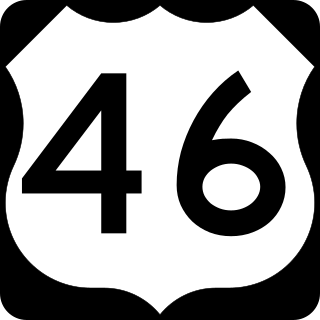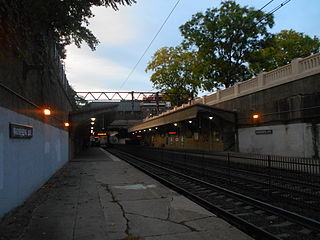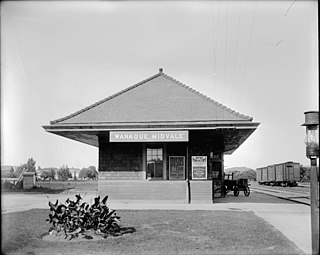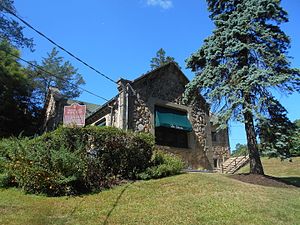
Mountain Lakes is a borough in Morris County, in the U.S. state of New Jersey, and a suburb of New York City. As of the 2020 United States census, the borough's population was 4,472, an increase of 312 (+7.5%) from the 2010 census count of 4,160, which in turn had reflected a decline of 96 (−2.3%) from the 4,256 recorded at the 2000 census.

U.S. Route 46 (US 46) is an east–west U.S. Highway completely within the state of New Jersey, and runs for 75.34 mi (121.25 km). The west end is at an interchange with Interstate 80 (I-80) and Route 94 in Columbia, Warren County, on the Delaware River. The east end is in the middle of the George Washington Bridge over the Hudson River in Fort Lee, Bergen County, while the route is concurrent with I-95 and US 1-9. Throughout much of its length, US 46 is closely paralleled by I-80. US 46 is a major local and suburban route, with some sections built to or near freeway standards and many other sections arterials with jughandles. The route runs through several communities in the northern part of New Jersey, including Hackettstown, Netcong, Dover, Parsippany-Troy Hills, Wayne, Clifton, Ridgefield Park, Palisades Park, and Fort Lee. It crosses over the Upper Passaic River at several points. The road has been ceremonially named the United Spanish–American War Veterans Memorial Highway.

The Main Line is a commuter rail line owned and operated by New Jersey Transit running from Suffern, New York to Hoboken, New Jersey, in the United States. It runs daily commuter service and was once the north–south main line of the Erie Railroad. It is colored yellow on NJ Transit system maps, and its symbol is a water wheel.

The Morristown Line is an NJ Transit commuter rail line connecting Morris and Essex counties to New York City, via either New York Penn Station or Hoboken Terminal. Out of 60 inbound and 58 outbound daily weekday trains, 28 inbound and 26 outbound Midtown Direct trains use the Kearny Connection to Penn Station; the rest go to Hoboken. Passengers can transfer at Newark Broad Street or Summit to reach the other destination. On rail system maps the line is colored dark green, and its symbol is a drum, a reference to Morristown's history during the American Revolution.
The Morris and Essex Railroad was a railroad across northern New Jersey, later part of the main line of the Delaware, Lackawanna and Western Railroad.

Newark Broad Street station is a New Jersey Transit commuter rail and light rail station at 25 University Avenue in Newark, New Jersey. Built in 1903, the station's historic architecture includes an elegant clock tower and a brick and stone façade on the station's main building. In June 1984, the station was added to the National Register of Historic Places in recognition of its historical significance.

Denville is an active commuter railroad train station in Denville Township, Morris County, New Jersey. Located on Estling Road, the station contains three side platforms–two curved low-level platforms that service New Jersey Transit's Morristown Line, and a third that services their Montclair-Boonton Line. Both platforms on the Morristown Line contain miniature high-level platforms for handicap accessibility. Trains on both lines operate between Hoboken Terminal, New York Penn Station and Hackettstown. Heading westbound, the next station is Dover while the next station east on the Morristown Line is Mount Tabor. The next station east on the Montclair-Boonton Line is Mountain Lakes.

Dover is an active commuter railroad train station in the town of Dover, Morris County, New Jersey. Located at the end of electric service, Dover station serves as a secondary terminal of NJ Transit's Morristown and Montclair-Boonton Lines. Non-electric service continues west to Hackettstown on both lines. The next station to the west is Mount Arlington while the next station to the east is Denville. Dover station consists of a single island platform, accessible for the handicapped.

Watsessing Avenue station is a New Jersey Transit rail station in Bloomfield, New Jersey, along the Montclair-Boonton Line. It is located beneath the Bloomfield Police Benevolent Association meeting hall near the corner of Watsessing Avenue and Orange Street in Bloomfield. It is one of two stations on the line where the boarding platform is below ground level. The Watsessing station and the Kingsland station in Lyndhurst on the Main Line shared similar designs and were built about the same time.

Little Falls station is a NJ Transit station located at Union Avenue in Little Falls, New Jersey. The station, on the Montclair-Boonton Line is the first to receive limited revenue service due to the end of electrification at the site of the former Great Notch station.

Mountain View, signed on the platform as Mountain View–Wayne, is a station on the Montclair-Boonton Line of NJ Transit in Wayne, New Jersey. Prior to the Montclair Connection in 2002, the station was served by the Boonton Line. The station is located on Erie Avenue, just off of US 202 and Route 23 in Downtown Wayne. Since January 2008, Mountain View station is the second of two stations in Wayne, the other being the Wayne Route 23 Transit Center, a station off the Westbelt interchange.

Boonton is a NJ Transit station in Boonton, Morris County, New Jersey, United States along the Montclair-Boonton Line. It is located on Main Street, near Myrtle Avenue and I-287. The original 1905 station was built by architect Frank J. Nies who built other stations for the Delaware, Lackawanna and Western Railroad. Unlike most of his stations which tended to be massive Renaissance structures, Boonton station was built as a simple Prairie House design. The station house is now a bar, and was added to the National Register of Historic Places on July 13, 1977, two years before the establishment of New Jersey Transit and six years before becoming part of their railroad division.

Kingsland is a railroad station on New Jersey Transit's Main Line. It is located under Ridge Road (Route 17) between New York and Valley Brook Avenues in Lyndhurst, New Jersey, and is one of two stations in Lyndhurst. The station is not staffed, and passengers use ticket vending machines (TVMs) located at street level to purchase tickets. The station is not handicapped-accessible. Originally part of the Delaware, Lackawanna and Western Railroad's Boonton Branch, the current Kingsland station was built in 1918. The station is currently planned to be closed.

Lyndhurst is a New Jersey Transit rail station located off of New York Avenue in Lyndhurst, New Jersey. The station is one of two in Lyndhurst, the other being Kingsland station. The Lyndhurst station is located at milepost 8.2 on the Main Line.

Passaic is a NJ Transit rail station served by Main Line trains in Passaic, New Jersey. The station is located in the Passaic Park section of Passaic at an intersection that links Passaic Avenue and Van Houten Avenue with Lackawanna Place. The Hoboken bound platform is located on the Passaic Avenue side of the station and the Suffern bound platform is located at the intersection of Van Houten Avenue and Lackawanna Place. Pedestrian access to both platforms is available on Passaic Avenue, but an underpass is also available to connect both sides.

The Montclair-Boonton Line is a commuter rail line of New Jersey Transit Rail Operations in the United States. It is part of the Hoboken Division. The line is a consolidation of three individual lines: the former Delaware, Lackawanna & Western Railroad's Montclair Branch, which ran from Hoboken Terminal to Bay Street, Montclair. The Erie Railroad's Greenwood Lake Division, a segment from Montclair to Mountain View-Wayne, originally ran from the Jersey City Terminal to Greenwood Lake, NY, and the former Lackawanna Boonton Line ran from Hoboken to Hackettstown, New Jersey.

Wanaque–Midvale was a former commuter railroad station of the Erie Railroad's New York and Greenwood Lake Railway branch in Wanaque, New Jersey, United States. When built in 1873, the station served trains running from Pavonia Terminal in Jersey City to Sterling Forest on the New York–New Jersey border alongside Greenwood Lake and trains going to Ringwood on the Ringwood Branch. At the time there were two stations, one at Wanaque and one at Midvale. The next station northbound towards Sterling Forest was Boardville; heading towards Ringwood it was Erskine. The next station south was Haskell.

Pompton–Riverdale is a former railroad station in the borough of Riverdale, Morris County, New Jersey, United States. Located at 13 Paterson–Hamburg Turnpike, the station was a stop on the Greenwood Lake Division of the Erie Railroad. A single side platform station with two tracks, the current station was built in 1919. The next station to the north was Pompton Junction, where connections were available to the New York, Susquehanna and Western Railroad, another Erie Railroad subsidiary. The next station south was Pompton Plains.

Haskell was a former commuter railroad station in the Haskell section of Wanaque, Passaic County, New Jersey, United States. Located at the Doty Road grade crossing in Wanaque, trains operated on the Erie Railroad's New York and Greenwood Lake Railway between Pavonia Terminal in Jersey City and Wanaque–Midvale station. The next station to the north was Wanaque–Midvale while the next station to the south from c. 1909–1930 was Pompton Junction. Afterwards, the next stop was Pompton–Riverdale. Haskell station consisted of a single low-level side platform and a three-sided shelter for protection.

North Newark was a former commuter railroad train station in the Woodside section of the city of Newark, Essex County, New Jersey. Located at the intersection of Broadway and Verona Avenue, the station served trains on NJ Transit's Boonton Line, which operated at the time between Netcong and Hoboken Terminal. The station consisted of two low-level side platforms, accessible by stairs from Broadway. The next station to the east was Arlington in nearby Kearny, with the next station to the west being Rowe Street in Bloomfield.






















